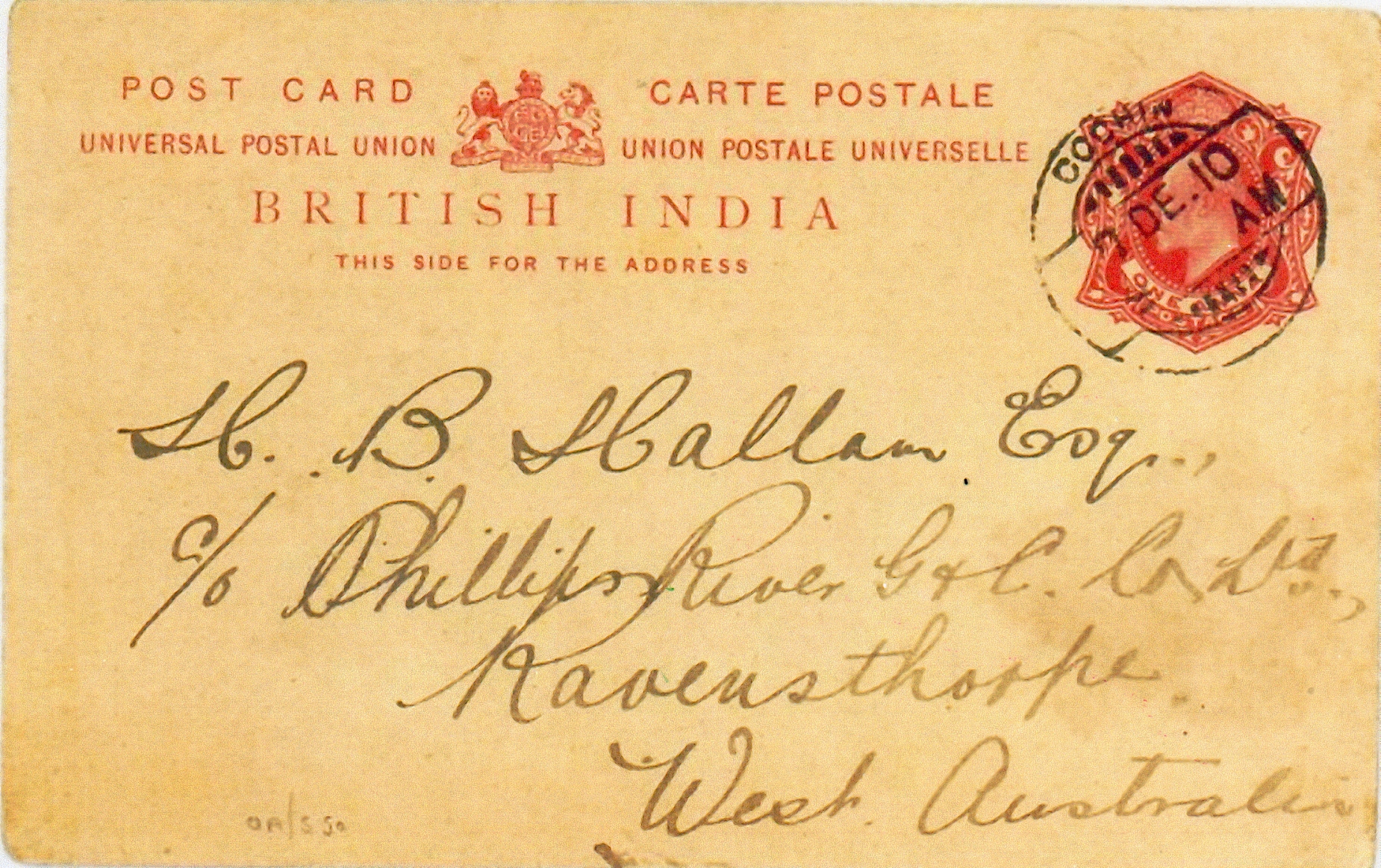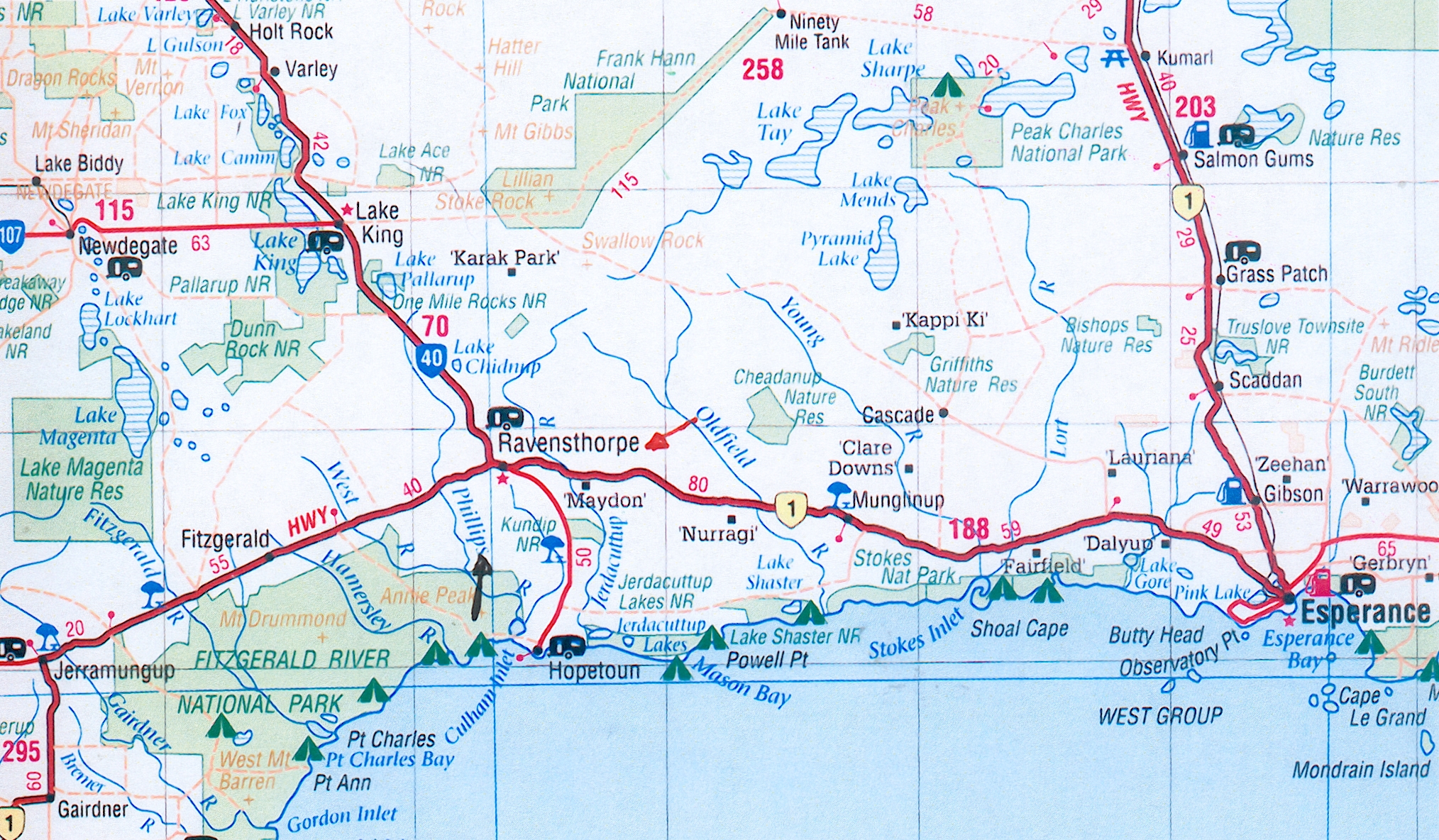This fine postcard was produced in British India and it has a red printed ‘ONE ANNA’ King Edward VII head stamp, postmarked COCHIN/ 7DE. 10/ AM. It is addressed to H.B. Hallam Esq., C/o Phillips River G (old) & C(opper) Co. Lrd., Ravensthorpe, West Australia (Figure 1).

The reverse is addressed Cochin, S. India and it was sent to “Dear Alge(rnon?) Just a line to wish you a Kerry Christmas, but don’t make it too merry. I wouldn’t mind being at the same place as we were last Christmas, but going the other way. [signed] R.W. Goodacre. (Figure 2).
.jpg)
My research did not find Mr. Goodacre in Cochin, India and no information was found on him in Ravensthorpe, Western Australia nor was there any connection found between him and the company.
Ravensthorpe is located 530 km south of Perth, and it is now a small sheep and wheat town, which started life as a gold and copper mining town. The area is again experiencing mining activity with nickel and gold mining project being developed. At the end of the nineteenth century, the gold mania which had seen the rise of towns like Kalgoorlie had reached fever pitch. In 1898 Jin Dunn(one of John Dunn’s brothers) found gold on the ‘Cocarnup’ property. Overnight prospectors poured into the area and the Phillip’s River goldfield was established. As with all gold towns the development of Ravensthorpe was hysterical. In 1909 the town was surveyed, and it was gazetted the following year. The population had grown to 500, a school had opened up with 19 students. The Dunn brothers were eager to capitalize on their increased fortunes, and when land in the new town was offered for sale in 1901 they purchased two lots in the main street and built the Miners Arms Hotel and a General Store.
Prior to World War One the town continued to grow and by 1909 the population had reached 3,000. By 1918 the smelter and the mines had closed and most of the prospectors had moved away. The mines continued to operate depending on the price of copper, until the 1970’s, but the town never regained the vigour it enjoyed prior to World War One. The present nickel mining activity in Ravensthorpe has attracted new residents to the area.
In The West Australian (Perth) 2 May 1899, a short paragraph wa found that stated Mr. Walter Dunn has given the Member for the Legislative Assembly, Mr. A.E. Morgans an option over his claims in the Phillips River district. Morgans will shortly send an expert down to examine the claims, and decide whether they are worth the large expenditure that would be necessary for thoroughly opening them up. Mr, Dunn has placed them under offer as prospecting (results) show. There was a follow-up in the same newspaper on the 29 May 1899 employed by Morgans reported the discovery of copper at Phillips River, but until assays were completed he could not make a statement.
In The West Australian (Perth) 30 June 1900, Dr. Chewings produced a rough sketch map of the Phillips River Field in relation to the Ravensthorpe Range which skirts the present discoveries on the north, north east and east. The information he obtained from prospectors suggested that the valuable minerals might extend from 30 to 40 miles east and west by, say, 20 miles north and south. He stated that much of the quartz is “undoubtedly of good payable grade”.
All I have learnt about Mr. H.B. Hallam by my personal research can be stated in a single sentence: Mr. H.B. Hallam as the Superintendent of the Phillips River Gold and Copper Company Ltd. and The West Australian (Perth) on 21 April 1913 he was bid farewell by the Ravensthorpe residents at the Commercial Hotel. I contacted the Ravensthorpe Historical Society and their archivist provided the following information: “Mr. H.B. Hallam appears on our postal directories under Ravensthorpe for 1912 and 1913 as an accountant. The Phillips River Mining Company NL was incorporated August 1900. The company appears to have lasted until 1909. There was a Phillips River Gold and Copper Mining Co Ltd registered London 6 January 1906. They owned several mines, and a smelter. The company wound up in June 1912. The Phillips River Goldfield dates back to 1900 and still exists by that name. We have no record of Mr. RW Goodacre (the man who sent the postcard). ‘A History of Mining at Ravensthorpe, Western Australia’ 1987 unpublished by M Keith Quartermaine was commissioned by Shire of Ravensthorpe. I have looked through this and so far I have not found any reference to Hallam or Goodacre. I hope that this is of some assistance to you although the information is somewhat limited! Ann Williams Archivist Ravensthorpe Historical Society Inc.”
The position of Ravensthorpe, W.A. (red arrow) and the Phillips River (black arrow) are seen in Figure 3.
